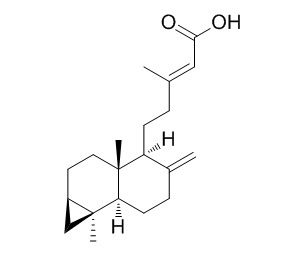Metasequoic acid A
Standard reference
Inquire / Order:
manager@chemfaces.com
Technical Inquiries:
service@chemfaces.com
Tel:
+86-27-84237783
Fax:
+86-27-84254680
Address:
1 Building, No. 83, CheCheng Rd., Wuhan Economic and Technological Development Zone, Wuhan, Hubei 430056, PRC
Providing storage is as stated on the product vial and the vial is kept tightly sealed, the product can be stored for up to
24 months(2-8C).
Wherever possible, you should prepare and use solutions on the same day. However, if you need to make up stock solutions in advance, we recommend that you store the solution as aliquots in tightly sealed vials at -20C. Generally, these will be useable for up to two weeks. Before use, and prior to opening the vial we recommend that you allow your product to equilibrate to room temperature for at least 1 hour.
Need more advice on solubility, usage and handling? Please email to: service@chemfaces.com
The packaging of the product may have turned upside down during transportation, resulting in the natural compounds adhering to the neck or cap of the vial. take the vial out of its packaging and gently shake to let the compounds fall to the bottom of the vial. for liquid products, centrifuge at 200-500 RPM to gather the liquid at the bottom of the vial. try to avoid loss or contamination during handling.
Korean J. of Horticultural Sci. & Tech. 2017, 793-804
Cell Chem Biol.2019, 26(1):27-34
Bull. Pharm. Sci., Assiut University2020, 43(2):149-155.
Anal Chim Acta.2018, 1039:162-171
Nutrients.2019, 12(1):E40
J Med Food.2020, 23(6):633-640.
New Zealand J. Forestry Sci.2014, 44:17
Journal of Life Science2018, 917-922
The Journal of Animal & Plant Sciences.2020, 30(6):1366-1373
Evid Based Complement Alternat Med.2021, 2021:5319584.
Related and Featured Products
Parasit Vectors. 2016 May 31;9(1):312.
Antifilarial activity of diterpenoids from Taxodium distichum[Pubmed:
27245322]
Lymphatic filariasis caused by Wuchereria bancrofti, Brugia malayi and B. timori, is a debilitating disease with an adverse social and economic impact. The infection remains unabated in spite of treatment with existing antifilarial drugs diethylcarbamazine (DEC) and ivermectin which are chiefly microfilaricides. There is therefore, need for macrofilaricides, embryostatic agents and better microfilaricides.In the present study we explored the antifilarial potential of crude extract and its molecular fractions of the plant Taxodium distichum using in vitro assay systems and rodent models of B. malayi infection.
METHODS AND RESULTS:
Ethanolic extract (A001) of aerial parts of T. distichum was solvent fractionated and sub-fractionated. Four molecules, 3-Acetoxylabda-8(20), 13-diene-15-oic acid (K001), Beta-sitosterol (K002), labda-8(20),13-diene-15-oic acid (K003) and Metasequoic acid A (K004) were isolated from the fractions and their structure determined by spectroscopic analysis. The extract, subfractions and molecules were evaluated for antifilarial activity against B. malayi by 3-(4,5-dimethylthiazol-2-yl)-2,5 diphenyltetrazolium bromide (MTT) reduction and motility assays in vitro and in two animal models, Meriones unguiculatus and Mastomys coucha, harbouring B. malayi infection.A001 was effective in killing microfilariae (mf) and adult worms in vitro. The diterpenoid K003 produced 100 % reduction in motility of both mf and adult worms and > 80 % inhibition in MTT reduction potential of adult female worms. In B. malayi-M. unguiculatus model, A001 killed all the adult worms in > 80 % of infected animals. K003 was embryostatic (> 95 %) in this model. In the B. malayi-M. coucha model, K003 killed ~54 % of adult worms (macrofilaricidal activity) and rendered > 36 % female worms sterile; it also stopped any further rise in microfilaraemia after day 42 post-initiation of treatment.
CONCLUSIONS:
Ethanolic extract of aerial parts of the plant T. distichum possesses potent antifilarial activity and the active principle was localised to K003 which showed significant macrofilaricidal activity and late suppression of peripheral microfilaraemia and some embryostatic activity. These findings indicate that labdane diterpenoid molecule(s) may provide valuable leads for design and development of new macrofilaricidal agent(s). To the best of our knowledge, this is the first report on antifilarial efficacy of products from the plant T. distichum.



